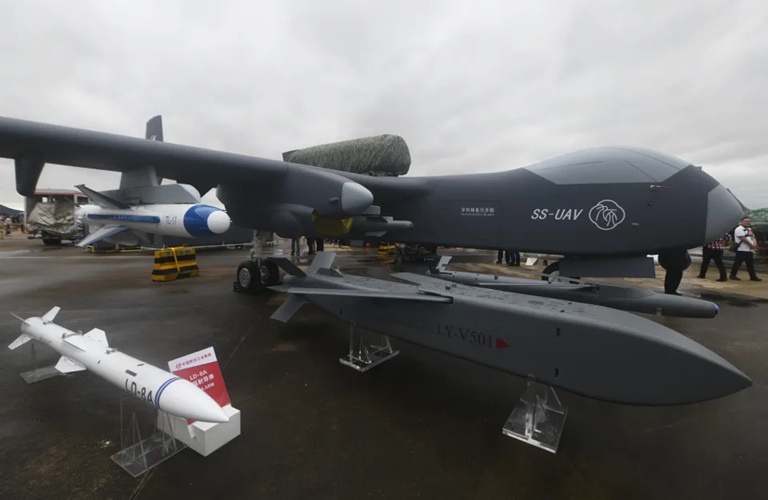China’s Jiu Tian “drone mothership”—formally the SS-UAV Queen Drone—is poised to embark on its maiden mission by the end of June 2025, marking a leap in the People’s Liberation Army’s (PLA) uncrewed air combat arsenal. With a service ceiling of approximately 15,000 m (50,000 ft) and an unrefueled range nearing 7,000 km (4,350 mi), Jiu Tian combines long endurance with high-altitude operation, enabling deep strikes and persistent surveillance over contested regions such as the South China Sea and Taiwan Strait. Its modular “beehive” bay can carry up to six tonnes of payload—ranging from sensor suites to as many as 100 loitering munitions—ushering in a new era of swarming, AI-driven drone warfare that China bills as a “multi-role” platform.
Technical Specifications and Design
Airframe and Propulsion
Jiu Tian features a jet engine mounted atop its fuselage, optimizing high-altitude performance and rapid transits to operational areas. It sports a wingspan of roughly 25 m (82 ft) and a fuselage length near 16 m, with a maximum take-off weight of about 16 tonnes. The H-shaped tailplane and slender wing design are intended to reduce drag and enhance loitering endurance at stratospheric altitudes, where Jiu Tian can operate largely above medium-range air defense envelopes.
Endurance and Range
With an advertised range of approximately 7,000 km, Jiu Tian can cover vast distances without refueling, extending the PLA’s uncrewed reach far beyond China’s littoral regions. Endurance figures estimate up to 12 hours on station, giving the platform significant persistence for reconnaissance, electronic warfare, and kinetic missions.
Payload and Swarm Capability
Modular Mission Bay
Central to Jiu Tian’s concept is its modular “beehive” bay, capable of accommodating up to six tonnes of varied payloads—from additional fuel tanks and electronic warfare pods to reconnaissance sensors. The bay can house up to 100 small “suicide” or loitering munitions, which are ejected in coordinated swarms to overwhelm air defenses through sheer mass and networked autonomy.
Swarm Tactics and AI Integration
China envisions swarms of low-cost drones executing precision strikes, jamming enemy radars, and acting as decoys to saturate adversary counter-UAV systems. By leveraging AI algorithms and secure datalinks, these swarm elements can adapt in real time to dynamic threats, redistributing themselves across multiple targets or evading incoming fire through coordinated maneuvers.
Strategic Implications
Extending the PLA’s Reach
Jiu Tian’s combination of altitude, range, and payload radically extends the PLA Air Force’s uncrewed combat radius, potentially enabling strikes on island chains, maritime chokepoints, and inland military installations hundreds of kilometers from Chinese bases. Persistent surveillance and strike options above the Taiwan Strait and South China Sea could complicate adversary defense planning, forcing joint forces to reposition sensors and interceptors further from coastlines.
Multi-Role Applications
Beyond kinetic missions, Jiu Tian is touted for reconnaissance, signals intelligence, and electronic warfare roles, where its high-altitude vantage and modular payloads can support jamming, communications relay, and sensor fusion. State media emphasize the platform’s “peace-oriented” nature, suggesting potential civilian uses such as disaster response, environmental monitoring, and high-altitude communications relay.
Criticisms and Vulnerabilities
Lack of Stealth and Survivability
Critics have derided Jiu Tian as “large, slow, and not stealthy,” warning that advanced integrated air defense systems—such as the U.S. Patriot PAC-3 and Russia’s S-400—could track and engage the platform despite its altitude advantage. The conspicuous airframe and thermal signature of its jet engine may render it an easy radar and infrared target for long-range SAM batteries and fighter-borne interceptors.
Electronic Warfare Counter-measures
Adversaries could exploit jamming and spoofing to sever swarm datalinks or corrupt AI algorithms, causing swarms to scatter or self-destruct prematurely. Decoy and electronic decoy UAVs may further deplete Jiu Tian’s stock of loitering munitions before they reach high-value targets.
Regional and Global Reactions
Taiwan’s Defensive Posture
Taipei has publicly warned of a “drone hellscape” scenario if Jiu Tian and similar platforms become operational, prompting accelerated procurement of counter-UAV systems, hardened shelters, and electronic warfare assets to protect key infrastructure.
U.S. and Allied Responses
The United States and its regional allies are increasing joint exercises focused on integrated multi-domain defenses against drone swarms, including air-sea coordination and rapid interceptor deployment. Investments in directed-energy weapons, high-powered radar, and AI-driven C2 systems aim to negate the massing advantage of swarm tactics.
Future Prospects
China is reportedly already planning next-generation unmanned platforms featuring stealthy flying-wing designs and carrier-based launch capabilities from amphibious ships. Lessons learned from Jiu Tian’s early flights will likely inform improvements in radar cross-section reduction, engine exhaust cooling, and AI robustness against electronic interference.
Conclusion
As Jiu Tian prepares for its inaugural June mission, the PLA stands on the cusp of operationalizing large-scale drone swarm warfare—a concept that could redefine air combat doctrines worldwide. While the platform’s impressive range, altitude, and payload open new strategic horizons, significant questions remain about its survivability against modern air defenses and electronic warfare measures. The next few months of testing will be critical to assess whether Jiu Tian represents a formidable “lethal weapon” or an over-ambitious showcase of China’s uncrewed ambition. If successful, drone motherships may become a staple of future conflicts, compelling militaries to adapt to a new era of massed, AI-driven aerial operations.
